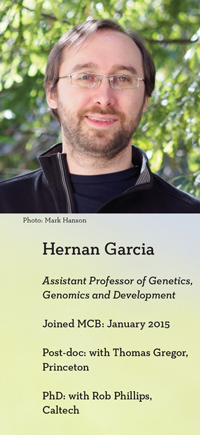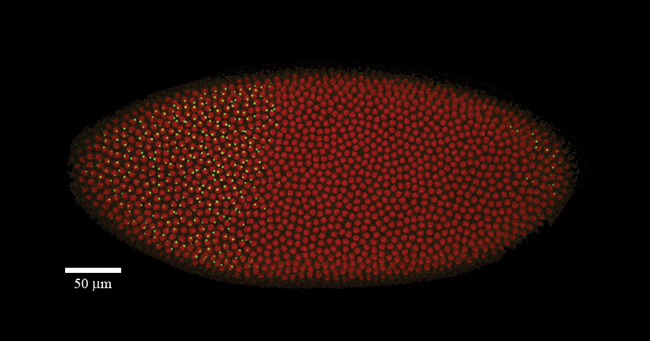MCB TRANSCRIPT

Quantifying Development: The Physical Basis of Differentiation
Can we learn to read DNA the way cells do, and use that to predict their decisions? MCB assistant Professor Hernan Garcia thinks so. He’s already done it in bacteria and now he wants to do it in a far more complex system: developing fruit flies.

“DNA is the one piece of information the fly begins with,” he says, adding that regulatory programs convert DNA into an adult body plan. “Can I predict what the organism will look like from looking at its DNA sequence?”
Trained as a physicist, Garcia naturally thinks of biological systems in terms of quantifying inputs (such as concentrations of DNA binding proteins) and outputs (such as gene activity). As a graduate student, he showed that he could predict how much sugar bacteria would eat based on just two inputs: the concentration of a DNA binding protein that senses sugar, and the binding site affinity. “It was super fun,” he says.
As a post-doc, Garcia pioneered a live microscopy technique for watching fruit fly embryos develop in close to real time. “The technique existed for single cells but everyone said it didn’t work for multi-celled organisms — never trust that!” he says. His technique is now being used in more than a dozen labs around the world.
Today he’s using live microscopy to investigate cells in early fruit fly embryos before you can see even a hint of the adult body plan. “At 180 minutes, the cells all look the same but they have already decided what they will be when they grow up,” Garcia says. “I’m focusing on how cells get to that state.”
To find out, he’s using fluorescent tags to label the proteins made by specific genes, which lets him track the patterns of gene activity that differentiate these thousands of look-alike cells. “We engineered the fly so it can report on the developmental process,” he says. And as a first step in quantifying these regulatory programs, he’s testing DNA binding proteins that activate the 20-30 genes involved in early embryonic differentiation in fruit flies.
Garcia is inspired by the cartoons of biological processes in textbooks, and hopes to take them even further. “I want to turn cartoons into precise mathematical models,” he says. “That will sharpen the questions we can ask and will open the door to new queries about biology.”
Garcia is pleased to be part of MCB. “My work is very interdisciplinary, combining physics, biology and imaging,” he says. “UC Berkeley is an amazing place to do this because there are people here who are world experts at all these things.”

(green dots) that will lead to the adult body plan.




